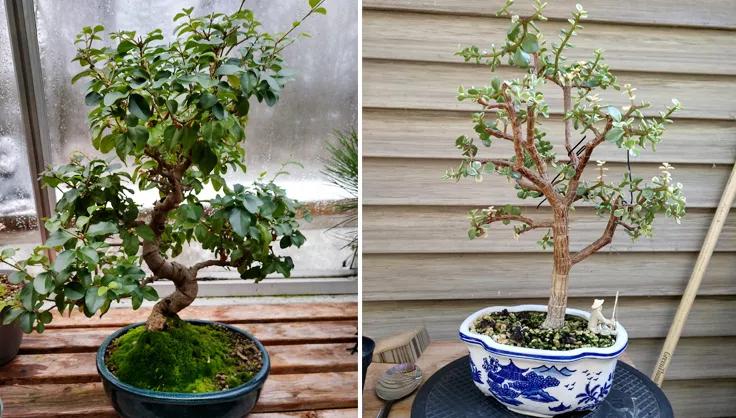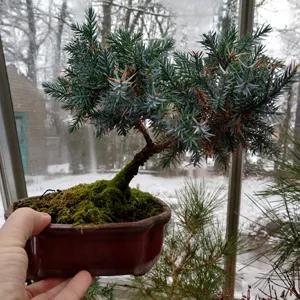A Beginner’s Guide to Beautiful Bonsai

Photo Credit: Richard Bounds
Richard Bounds started growing bonsai over a decade ago when a friend gave him a handful of Japanese maple seeds and a starter kit. Fast forward to 2023 and Richard, also a Software Engineer with Gardener’s Supply Company, now cultivates over 20 bonsai plants, including a wisteria that refuses to flower, an adopted English Ivy more than 70 years old, and a spruce rescued from a neighbor ripping out his hedge.
“Having more than one is good,” says Richard. “They [bonsai] mostly like to be left alone, so having more than one makes you less likely to over-tend one.”
Translated from Japanese, “bonsai” means “planted in a container”. Stemming from ancient Chinese horticultural practices, and then later modified by Japanese Zen Buddhism, the practice of bonsai has been around for nearly one thousand years. The goal of bonsai is to grow realistic-looking trees that look fully grown but remain small in stature. Careful manipulation by the gardener guides the plant into the desired shape, while still retaining the correct scale of a full-size individual of that species. Bonsai plants are often characterized by their battle-hardened appearance, as if they’ve been withstanding the elements for centuries: swooping branches, gnarled surface roots bearing down on rocky terrain, and trunks leaning at dramatic 45-degree angles as if blasted by perpetual wind.
Easy Plants To Start Your Bonsai Journey
There are no genetically miniaturized, bonsai-specific species. It is a common misconception that bonsai are a type of indoor houseplant; in reality, most bonsai plants should be grown outside and exposed to the seasons (with the exception of tropical species), just as their full-size counterparts would. There are several plants popular with bonsai growers for their ease of care and striking form:
| Deciduous | Conifers | Broadleaf evergreen |
|---|---|---|
| Japanese maple (Acer palmatum) |
Juniper (Juniperus spp.) |
Jade (Portulacaria afra) |
| European beech (Fagus sylvatica) |
Japanese black pine (Pinus thunbergii) |
Ficus |
| Trident maple (Acer buergerianum) |
Colorado blue spruce (Picea pungens) |
Azalea (Rhododendron spp.) |
Growing bonsai from seed means you have full control over the shape and style of your plant from day one. Purchase seeds from a grower or collect seeds from trees in your area; the latter ensures that your seedlings will be growing in their preferred climate. Growing from seed can take 3-5 years before there is anything substantial enough to start shaping, so be prepared to settle in and wait. Using a cutting from another plant or acquiring a semi-mature plant provides a speedier alternative and is preferred by most bonsai gardeners.
Bonsai “Soil”
Bonsai plants are especially picky about their soil, which isn’t really soil in a biological sense, but rather a “soilless growing medium”. Bonsai require three things of their growing medium: drainage, water retention, and air flow. Gardeners should look for a chunky, coarse soil with plenty of nooks and crannies between each particle to allow oxygen to reach plant roots and promote growth of beneficial mycorrhizae fungi.
Bonsai soil generally includes the following inorganic (non-living) components:
Akadama
A granular, hard-baked Japanese clay that simultaneously provides good drainage and water retention. Like regular gravel, it drains well, however unlike gravel, each individual akadama particle is extremely porous and will hold and release water over time.
Pumice
A soft volcanic rock that helps to lighten the consistency of the soil.
Lava rock
A coarse rock that provides structure and promotes aeration, making for healthy roots.
Prior to mixing these 3 inorganic ingredients, sift the akadema and lava rock to remove fine dust particles. Adding a small amount of organic compost or pine bark (which doesn’t decompose as quickly) to the above mix can be beneficial to certain species, however most of the plant’s nutrition can be acquired from a good fertilizer. Start with this mixture but know that the exact recipe will vary from plant to plant:
- Conifers: 33% akadama, 33% pumice, and 33% lava rock
- Deciduous plants: 50% akadama, 25% pumice, and 25% lava rock
Mixing these individual ingredients to create a custom growing medium requires some trial and error. Richard refers to building his bonsai soil as “a story in experimentation”. Don’t be afraid to tinker with your recipe and amend if your plant isn’t thriving.

“Planted In A Container”
Choosing the correct container for your bonsai is essential, perhaps more so than any other form of gardening. Not only does the container support healthy physical growth of the plant, but it needs to complement and elevate the plant, artistically speaking. The width of the container is approximately equal to 2/3 the height of the tree. The depth of the container is at least the diameter of the trunk. The color and shape of container needs to harmonize with the color and shape of the plant itself. At the very least, the bonsai container must have holes on the bottom for proper drainage, as well as two additional holes to thread support wires through. Use a small handheld trowel to nestle the plant carefully in your chosen container. Then, loop the support wires around the roots to ensure the plant doesn’t tip out of its shallow container.
Watering & Fertilizing Bonsai
Knowing when to water bonsai plants should be based on observation and not a strict schedule. Allow soil to dry thoroughly between waterings; most bonsai plants will not tolerate “wet feet”. If the soil feels damp for several days after watering, consider increasing the amount of lava rock in the growing medium to improve drainage. Use a watering can with a fine nozzle to prevent “pressure-washing” the soil right out of the container.
Being at the mercy of a small container and low-nutrient soil, bonsai plants require a regular dose of fertilizer. Bonsai plants should be fertilized spring through mid-autumn, then allowed to go dormant during the winter, mimicking the seasonal life cycle of their full-grown counterparts.
Where Art and Horticulture Collide: Shaping & Styling Bonsai
When it comes to shaping their plants, a successful bonsai gardener needs an eye for design, an understanding of traditional bonsai styles (of which there are over a dozen), and knowledge of a plant’s biology to ensure they don’t inadvertently kill the plant. Pruning is the most straightforward way to shape and maintain a bonsai plant. Clean, sharp pruning tools are a must. Concave, rounded pruners prevent damage to the main trunk while you remove a branch. Fine-pointed scissors provide precision cuts for tiny leaves and stems.
In addition to pruning, several other techniques are used to shape bonsai:
- Pinching: removing the tip of a shoot with your fingers
- Defoliating: removing all the leaves to encourage the growth of new, smaller leaves
- Wiring: wrapping wire around specific branches to bend and redirect them
Visit a traditional bonsai garden and you’ll likely see a variety of other plants nestled between the bonsai. Moss, ferns, grasses, and flowering plants (Richard favors lush clusters of mini hostas to accent his display), not only elevate the main stars of the show, but also create a sense of unity and place. You can almost visualize the time of year and climate just by the surroundings.
The most challenging aspect of bonsai? For Richard, it’s the fact that not all plants succeed. “It’s disappointing to start three plants and then lose two of them.” And perhaps that’s where growing bonsai is just like every other form of gardening. Patience, acceptance, and a creative spirit will always serve a gardener well no matter what’s being grown!
Print this Article:
Get the Dirt
Stay up to date on new articles and advice. Please fill out the information below.

